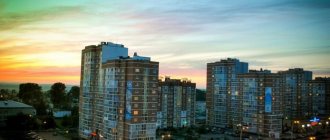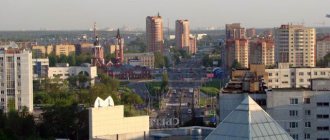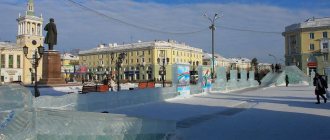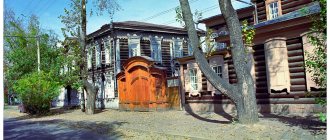Where is Belgorod?
Belgorod is the administrative center of the Belgorod region.
The city is located in the southern part of the central zone of the European part of Russia on the outskirts of the Central Russian Upland, which is 700 kilometers from Moscow to the south and not far (40 km) from the state border with Ukraine (the nearest city is Kharkov). Belgorod is washed by the Vezelki and Seversky Donets rivers, on which the Belgorod reservoir was built. In Belgorod, Moscow time (MSK) is in effect, which is 3 hours ahead of Coordinated Universal Time (UTC+3).
Belgorod map
The city has an area of just over 150 sq. km. administratively divided into two industrial districts - Western and Eastern and four residential (Central, Southern, Western and Eastern), plus settlements included in the Belgorod agglomeration.
The map of Belgorod explains well why the area of the provincial city is so large. Most of the central part is occupied by industrial sites for production and mining, the western region is mountainous, with steep elevation changes. The private sector is shrinking, and high-rise buildings are being built chaotically.
For tourists, I would first of all recommend Cathedral Square, Grazhdansky and B. Khmelnitsogogo avenues, and Narodny Boulevard.
Airport
Belgorod is served by the international airport of the same name, located in the Eastern District (formerly Sverdlovsk District), which is approximately 4 km from the city center in a northern direction. Buses run between the airport and different parts of the city.
At the moment, planes of Russian airlines are mainly based here, and most of the flights are to regional destinations within Russia. The most popular of them are Moscow, St. Petersburg, Novy Urengoy, Nyagan, Noyabrsk and Kaliningrad. According to the seasonal schedule, planes fly from Belgorod airport to Simferopol and Antalya (in summer), as well as to Phuket, Thailand (in winter).
History of Belgorod
The city was founded around the 10th century on the site of a settlement of Slavic tribes. But it was precisely how the city of Belgorod gained fame by the 15th century, which is reflected in the chronicles.
The thousand-year history of Belgorod contains many events and wars. After Belgorod was burned by the Poles and Lithuanians in 1612, the city’s fate was sealed - to become a large military-administrative district protecting the southern borders of Rus'. In 1658, the Belgorod Regiment was formed and the Belgorod Line was erected.
The years of the Second World War were the most tragic in the history of the city. Belgorod was almost completely destroyed, bloody battles were fought in these places.
Now Belgorod is a provincial city, whose authorities are making significant efforts to develop urban infrastructure, a tourist destination and improve the lives of citizens.
Train Station
The main passenger station in Belgorod, the Belgorod-Passenger station, is located on Vokzalnaya Street, 1. The station belongs to the South-Eastern Railway Network. Both commuter trains and long-distance trains depart from the station. Popular short-distance electric train destinations are Kursk, Rzhava station (Pristen village, Kursk region) and Prokhorovka village, Belgorod region.
Long-distance trains within the country depart daily or several times a week to Moscow, St. Petersburg, Rossosh, Novosibirsk and Vorkuta with stops in intermediate settlements. All trains passing in transit through Belgorod go to Ukrainian cities - Kharkov, Krivoy Rog and Dnieper (until recently - Dnepropetrovsk).
Historical facts of the city
In the place where Belgorod is located today, the first settlements of the Eastern Slavs appeared in the 8th century, but soon the northerners were forced to leave their lands, unable to withstand the pressure of the Pecheneg nomads. Further events developed as follows:
- 884 - The wars of the Kyiv prince Oleg liberate the lands of present-day Belgorod from the Pechenegs.
- 965 - The territory becomes part of the Pereyaslavl principality.
- 1593-1596 — Estimated years of construction of the Belgorod discharge.
- Second decade of the 17th century. — The fortress was destroyed after the invasion of Polish-Lithuanian troops, but was soon restored. For this purpose, the left bank of the Seversky Donets was chosen.
- 1646 - After the attack of the Zaporozhye Cossacks, the fortress was moved to the opposite bank - closer to the bed of the Vezelka River.
- 1658 - Belgorod becomes the main city of the so-called Belgorod Line.
- 1708-1765 — It is the main city in the Belgorod province, but soon becomes a district town in the Kursk province.
- 1918 - After the Treaty of Brest-Litovsk was concluded, Belgorod first became part of the Ukrainian state declared by Hetman Skoropadsky, and then part of the RSFSR, and from 1919 to 1920 it was one of the strongholds of the white movement.
- 1922 - Becomes part of the newly formed USSR.
- From 1941 to 1943 — Survives two occupations by the German army.
- 1954 - The Belgorod region appears on the map of the country, and Belgorod becomes its administrative center.
Bus stations in Belgorod
There are two bus stations in Belgorod - (Khmelnitsky Avenue, 160) and the auxiliary "Belgorod-2" (Grazhdansky Avenue, 1). From the central bus station there are daily buses to Moscow, Kursk, Smolensk, Volgograd, Voronezh, Orel, Lipetsk, Saratov and other cities. There are also international flights to Ukraine (Donetsk, Kharkov, Dnepr/Dnepropetrovsk, Sumy and Kyiv) and Moldova (Chisinau).
The Belgorod-2 bus station mainly serves commuter buses departing to various localities in the Belgorod, Kursk, Lipetsk, and Voronezh regions. Buses also run from here to Moscow and Kharkov.
Belgorod
Video: Winter Belgorod from above
Basic moments
Nowadays, Belgorod is a large city with a well-developed infrastructure, which is a scientific, economic, cultural and at the same time spiritual center.
The city attracts tourists with its magnificent architecture, numerous streets (there are 576 of them in the city!), picturesque boulevards and avenues, the total length of which is as much as 460 km. In addition, Belgorod is a major transport hub of the country.
It should be noted that Belgorod is the winner of awards for the livability of the city.
You should come to Belgorod to visit the city’s museums – the Art and Literary Museums, and also visit the Academic Theater. Shchepkin, view the diorama “Battle of Kursk” and visit numerous cathedrals in Belgorod.
Tourists can stay in one of the comfortable hotels in Belgorod and have a meal in the city's upscale restaurants.
Climate
The climate of Belgorod belongs to the temperate continental type. In summer the city is dry and hot, and in winter it is quite cool.
Attractions
Belgorod's attractions include numerous museums, theaters and architectural attractions.
For example, you should see the House of Merchant Selivavnov, which houses the Literary Museum, and the mansion of the merchant Goltsov, dating back to the 19th century. The buildings of the Women's Gymnasium on Narodny Boulevard and the residential building on Slavy Avenue are interesting from an architectural point of view. In addition, do not ignore the Volkova estate.
Other interesting places in Belgorod are religious: this is the Transfiguration Cathedral, which is the main temple of the Belgorod-Starooskol diocese, the ancient Smolensk Cathedral, the Assumption-Nicholas Cathedral and others.
In addition, the attractions of Belgorod include the diorama “Battle of Kursk”, as well as the Museum of Local Lore.
Excursions
Excursions in Belgorod are a unique opportunity to get to know the city and its surroundings better.
Thus, the most popular is the sightseeing tour “Belgorod in the Past and Present”. During the sightseeing tour, tourists can view the “Battle of Kursk” diorama, visit the Literary Museum, the Museum of Folk Culture, the Museum of Communications and see other sights of Belgorod.
The following excursions in Belgorod are also interesting: “Holy Belogorye” - a tour of the religious places of the city, an excursion to the Shchepkin Museum, an excursion to the village of Prokhorovka and a visit to the military history museum, a visit to the village of Kupino and the museum “Peasant Compound” and many other excursions of Belgorod.
Story
The history of Belgorod began as the history of a fortress that defended the southern borders of Rus' from the devastating raids of the Tatars from the Crimea. It is believed that the city was founded in 1593, but the first mentions of it date back to an earlier time.
During the Time of Troubles, the history of Belgorod was connected with the Polish-Lithuanian invasions, which destroyed the city to the ground. In general, it is interesting that during the entire period of its existence the city changed its location not once, but three times!
In the 17th century, the history of Belgorod was again turbulent - in total, over 100 years, the city was raided more than 10 times.
The population consisted of Russian peasants, as well as immigrants from Poland and Lithuania. Thus, the history of Belgorod was closely connected with neighboring states.
Until the 18th century, Belgorod was an important strategic point.
Since the 18th century, Belgorod became a district city of the Kursk province.
In peacetime, crafts actively developed in Belgorod, the city conducted active trade, and developed its economy. In particular, the city is famous for its shoemakers, blacksmiths, sheepskin makers, and tanners.
In 1869, the history of Belgorod made a sharp turn: the Kursk-Kharkov-Azov railway was built here. This influenced the growth of the population of Belgorod; industrial enterprises and educational institutions opened in the city.
By the beginning of the 20th century, Belgorod was already a rich county town.
Accommodation
Hotels in Belgorod are modern and comfortable hotels located both in the city itself and on its outskirts.
Note that a night in a Belgorod hotel will cost a tourist from 800 rubles.
The city has both state hotels and private hotels.
Among the best hotels in Belgorod are “Mir” (from 2 thousand rubles), “Milan” (from 2,800 rubles), “Belogorye” (from 3,500 rubles).
More budget options are the Polar Star hotel (1,700 rubles), Success (1,000 rubles).
Sports and active recreation
Active recreation in Belgorod is very popular and very well developed.
So, in the Virazh sports complex you can go karting. The cost of 10 minutes of pleasure is from 2540 rubles.
Paintball is also popular in Belgorod - there are 5 paintball clubs in the city.
Other active recreation activities in the city include roller skating and skiing, parachute jumping at the aviation sports club, and aeronautics.
Transport
Transport in Belgorod is mainly represented by buses and trolleybuses that run throughout the city. The total length of trolleybus routes is over 120 km.
In addition, the city has 2 bus stations, from where you can easily reach the suburbs by bus.
You can call a taxi in Belgorod from any hotel.
Souvenirs
Souvenirs of Belgorod are traditional souvenirs such as key rings, badges and refrigerator magnets with views of the city. Other interesting souvenirs are products of local craftsmen, ceramic products - cups, bells, as well as woven products. Don’t forget to take photographs - they can also become a memorable souvenir, reminiscent of your trip to Belgorod.
How to get there
There are several ways to get to Belgorod. For example, on an airplane. The city has an international class airport "Belgorod".
You can also get to the city by rail - the Belgorod railway station operates here. Travel time from Moscow to Belgorod by train is just over 9 hours.
You can also get to the city by bus: the travel time from Moscow to Belgorod by bus is 8 hours, the cost of tickets in 2013 is 900 rubles.
Automobile highways
The following main highways pass through Belgorod:
- M2 "Crimea". The federal highway from Moscow to the state border with Ukraine passes through Tula, Orel, Kursk and Belgorod. The route is an integral part of the E105 - the European route from Norway (the city of Kirkenes) to Yalta through the territory of Russia and Ukraine.
- P186. A regional highway from Belgorod to the border with Ukraine. Intersects with M2 "Crimea".
- 14K-1. Regional highway to Korocha.
Sights of the city of Belgorod
The city is rich in museums and parks; here you can find unique sculptural structures, as well as buildings and temples that are historical monuments. The most famous museums remain, marked on the map of Belgorod with streets:
- Local history on the street. Popov and the Diorama Museum dedicated to the Battle of Kursk;
- Literary on Preobrazhenskaya, 38;
- Ice cream on Dzgoeva, 2;
- Khudozhestvenny on st. Victory;
- The list of the most visited places in the city:
- Zoo on Volchanskaya, 292B;
- Belogorye Nature Reserve;
- Central Park named after Lenin on the street Nikolai Ostrovsky;
- Monastic Forest in Vinokurenny Log;
- Temple complex of the Marfo-Mariinsky Monastery on Pushkina, 19;
- Monument to Vladimir the Red Sun on Vatutina Avenue;
- Sculpture of an incorruptible traffic cop at the intersection of Volchansky and Korochansky streets;
- A sundial installed in the very center of the People's Boulevard.
Main streets of Belgorod
- st. Sumskaya - (from the village of Streletskoye to the intersection with Preobrazhenskaya Street) coincides with the location of the regional highway 14k-4 through the city; on the street there are exits to the exhibition and to the local botanical garden, and the building of the Oktyabrsky District Court is located on it;
- st. Studencheskaya - the Savino quarters and the old town are located on it (starts at the junction at the intersection with Korochanskaya Street and ends at the intersection with Michurina Street), this is a street with the 50th Anniversary of Victory Park, the center of Youth Initiatives, the famous stonemason sculpture, the largest in the city there is a car market and a cluster of service stations; bridge over the Seversky Donets;
- st. Chicherina - (starts from one of the branches of Sumskaya Street, coincides with the local bypass road) - there is a botanical garden on it, exit to the M2 federal road;
- st. Gubkin (starts at the intersection with Kostyukova Street in the Kharkov Mountain area, passes through the Molodezhny district and ends, intersecting with the bypass road) on it are the Bishop's Grove, the building of the children's regional hospital;
- st. Popova (starts at the intersection with Michurina Street and ends at Kharkovskaya Street) - it contains: the central park named after. Lenin, city administration building, Transfiguration Cathedral, central market; Victory Park; the drama theater building, the art museum and the diorama museum “Battle of Kursk”.
- st. Pobeda (starts at the intersection with Volochanskaya Street and ends at Gostenskaya Street) - here are the exits to the Marfo-Mariinsky Monastery, a youth center, a bicycle rental station, the Church of the Archangel Gabriel, Victory Park, and an art museum.
- st. Pushkina (a small street - stretches from Pobedy Street and ends at Narodny Boulevard) on which the building of the Energomash association and the Ministry of Internal Affairs Museum are located.
- Glory Avenue begins at the intersection with the street. Vokzalnaya and ends, turning into st. Sumskaya), here are the Belgorod Cathedral, the Museum of Communications, exits to the Pobeda cinema, the Smolensk Cathedral and the museum-workshop of the artist Stanislav Kosenkov, the Church of Alexander Nevsky.









